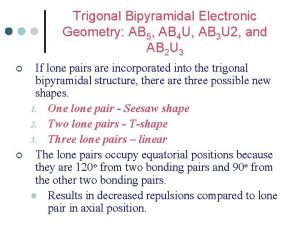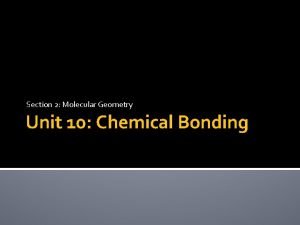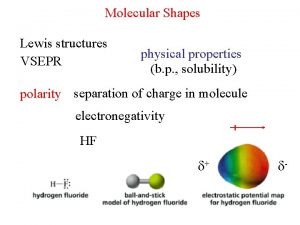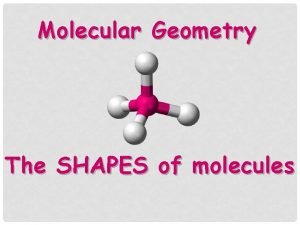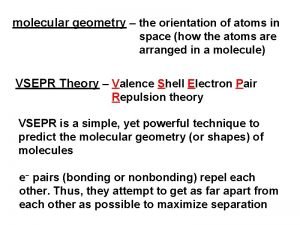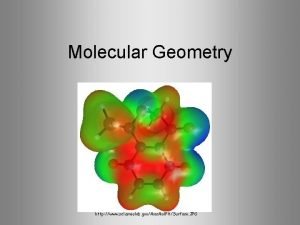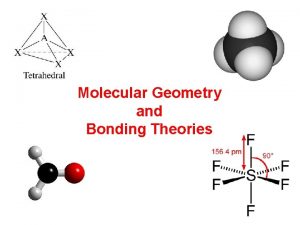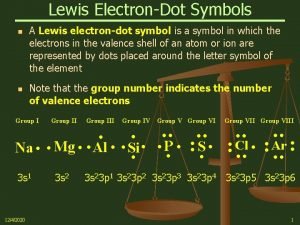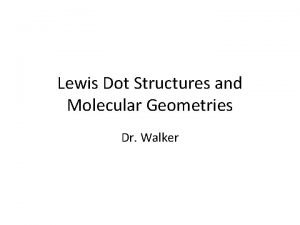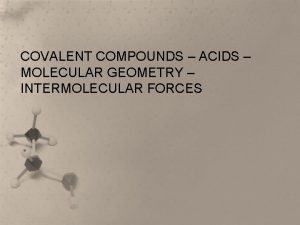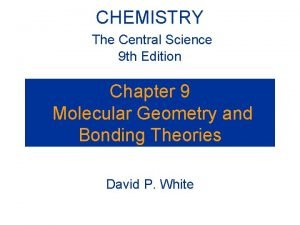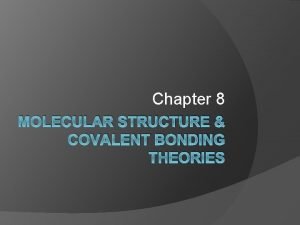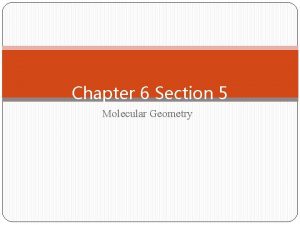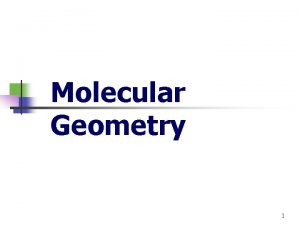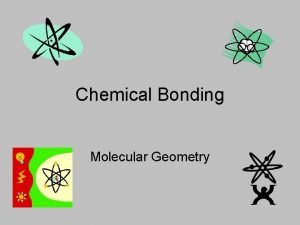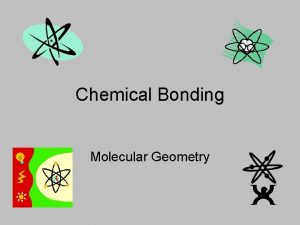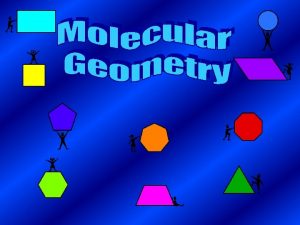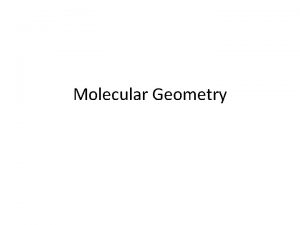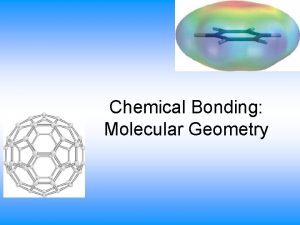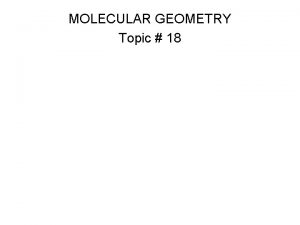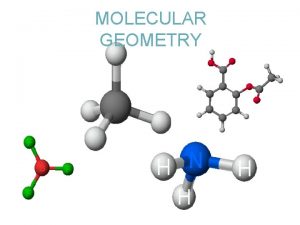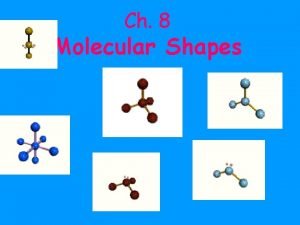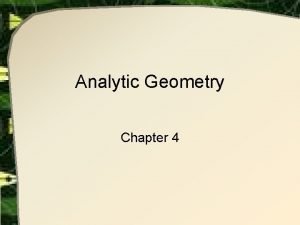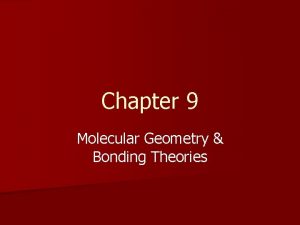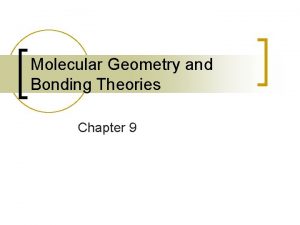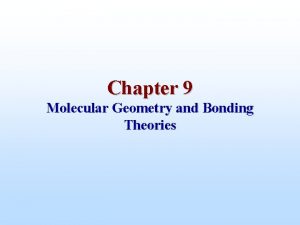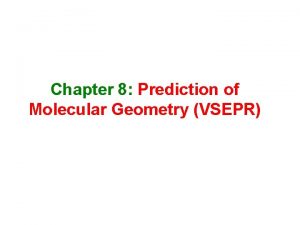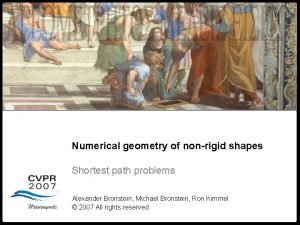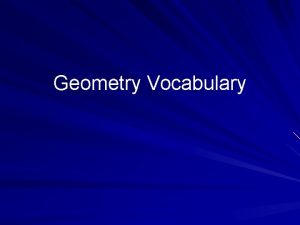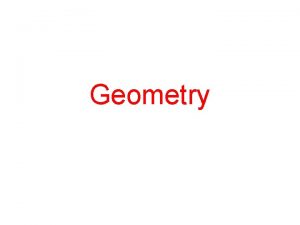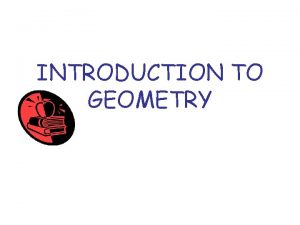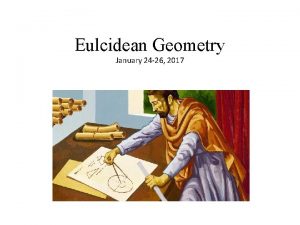Chapter 6 Section 5 Molecular Geometry Molecular geometry
























- Slides: 24

Chapter 6 Section 5 Molecular Geometry • Molecular geometry: three-dimensional arrangement of a molecule’s atoms. • Molecular polarity, or the uneven distribution of molecular shape. Chapter menu Resources Copyright © by Holt, Rinehart and Winston. All rights reserved.

Chapter 6 Section 5 Molecular Geometry VSEPR Theory • As shown at right, diatomic molecules, like those of (a) hydrogen, H 2, and (b) hydrogen chloride, HCl, can only be linear because they consist of only two atoms. Chapter menu Resources Copyright © by Holt, Rinehart and Winston. All rights reserved.

Chapter 6 Section 5 Molecular Geometry VSEPR Theory • The abbreviation VSEPR (say it “VES-pur”) stands for “valence-shell electron-pair repulsion. ” • VSEPR theory - repulsion between the sets of valence-level electrons surrounding an atom causes these sets to be oriented as far apart as possible. • example: Be. F 2 • The central beryllium atom is surrounded by only the two electron pairs it shares with the fluorine atoms. • According to VSEPR, the shared pairs will be as far away from each other as possible, so the bonds to fluorine will be 180° apart from each other. • The molecule will therefore be linear: Chapter menu Resources Copyright © by Holt, Rinehart and Winston. All rights reserved.

Chapter 6 Section 5 Molecular Geometry VSEPR Theory • Representing the central atom in a molecule by A and the atoms bonded to the central atom by B, then according to VSEPR theory, Be. F 2 is an example of an AB 2 molecule, which is linear. • In an AB 3 molecule, the three A–B bonds stay farthest apart by pointing to the corners of an equilateral triangle, giving 120° angles between the bonds. • In an AB 4 molecule, the distance between electron pairs is maximized if each A–B bond points to one of four corners of a tetrahedron. Chapter menu Resources Copyright © by Holt, Rinehart and Winston. All rights reserved.

Chapter 6 Section 5 Molecular Geometry VSEPR Theory Sample Problem E Use VSEPR theory to predict the molecular geometry of boron trichloride, BCl 3. Chapter menu Resources Copyright © by Holt, Rinehart and Winston. All rights reserved.

Chapter 6 Section 5 Molecular Geometry VSEPR Theory Sample Problem E Solution Boron trichloride is an AB 3 type of molecule. Its geometry should therefore be trigonal-planar. Chapter menu Resources Copyright © by Holt, Rinehart and Winston. All rights reserved.

Chapter 6 Section 5 Molecular Geometry VSEPR Theory • VSEPR theory can also account for the geometries of molecules with unshared electron pairs. • examples: ammonia, NH 3, and water, H 2 O. • The Lewis structure of ammonia shows that the central nitrogen atom has an unshared electron pair: • VSEPR theory postulates that the lone pair occupies space around the nitrogen atom just as the bonding pairs do. Chapter menu Resources Copyright © by Holt, Rinehart and Winston. All rights reserved.

Chapter 6 Section 5 Molecular Geometry VSEPR Theory • Unshared electron pairs repel other electron pairs more strongly than bonding pairs do. • This is why the bond angles in ammonia and water are somewhat less than the 109. 5° bond angles of a perfectly tetrahedral molecule. Chapter menu Resources Copyright © by Holt, Rinehart and Winston. All rights reserved.

Chapter 6 Visual Concepts VSEPR and Lone Electron Pairs Click below to watch the Visual Concept Chapter menu Resources Copyright © by Holt, Rinehart and Winston. All rights reserved.

Chapter 6 Section 5 Molecular Geometry VSEPR and Molecular Geometry Chapter menu Resources Copyright © by Holt, Rinehart and Winston. All rights reserved.

Chapter 6 Section 5 Molecular Geometry VSEPR and Molecular Geometry Chapter menu Resources Copyright © by Holt, Rinehart and Winston. All rights reserved.

Chapter 6 Section 5 Molecular Geometry VSEPR Theory Sample Problem F a. Use VSEPR theory to predict the shape of a molecule of carbon dioxide, CO 2. b. Use VSEPR theory to predict the shape of a chlorate ion, . Chapter menu Resources Copyright © by Holt, Rinehart and Winston. All rights reserved.

Chapter 6 Section 5 Molecular Geometry VSEPR Theory Sample Problem F Solution a. Draw the Lewis structure of carbon dioxide. There are two carbon-oxygen double bonds and no unshared electron pairs on the carbon atom. This is an AB 2 molecule, which is linear. Chapter menu Resources Copyright © by Holt, Rinehart and Winston. All rights reserved.

Chapter 6 Section 5 Molecular Geometry VSEPR Theory Sample Problem F Solution b. Draw the Lewis structure of the chlorate ion. � There are three oxygen atoms bonded to the central chlorine atom, which has an unshared electron pair. This is an AB 3 E molecule, which is trigonal-pyramidal. Chapter menu Resources Copyright © by Holt, Rinehart and Winston. All rights reserved.

Chapter 6 Section 5 Molecular Geometry • Hybridization - mixing of two or more atomic orbitals of similar energies on the same atom to produce new hybrid atomic orbitals of equal energies. • Ex: methane, CH 4 • Forms four identical orbitals called sp 3 orbitals. Chapter menu Resources Copyright © by Holt, Rinehart and Winston. All rights reserved.

Chapter 6 Section 5 Molecular Geometry of Hybrid Orbitals Chapter menu Resources Copyright © by Holt, Rinehart and Winston. All rights reserved.

Visual Concepts Chapter 6 Hybrid Orbitals Click below to watch the Visual Concept Chapter menu Resources Copyright © by Holt, Rinehart and Winston. All rights reserved.

Chapter 6 Section 5 Molecular Geometry • Intermolecular forces - forces of attraction between molecules • Weaker than those between metal atoms or ions. • Dipole-dipole forces - forces of attraction between polar molecules • Strongest molecular force Chapter menu Resources Copyright © by Holt, Rinehart and Winston. All rights reserved.

Chapter 6 Section 5 Molecular Geometry Comparing Ionic and Molecular Substances Chapter menu Resources Copyright © by Holt, Rinehart and Winston. All rights reserved.

Chapter 6 Section 5 Molecular Geometry Comparing Dipole-Dipole Forces Chapter menu Resources Copyright © by Holt, Rinehart and Winston. All rights reserved.

Chapter 6 Visual Concepts Dipole-Dipole Forces Click below to watch the Visual Concept Chapter menu Resources Copyright © by Holt, Rinehart and Winston. All rights reserved.

Chapter 6 Section 5 Molecular Geometry Intermolecular Forces • Hydrogen bonding - hydrogen atom bonded to a highly electronegative atom is attracted to an unshared pair of electrons of an electronegative atom in a nearby molecule • London dispersion forces - intermolecular attractions resulting from the constant motion of electrons and the creation of instantaneous dipoles Chapter menu Resources Copyright © by Holt, Rinehart and Winston. All rights reserved.

Chapter 6 Section 5 Molecular Geometry Hydrogen Bonding Chapter menu Resources Copyright © by Holt, Rinehart and Winston. All rights reserved.

Chapter 6 Visual Concepts London Dispersion Force Click below to watch the Visual Concept Chapter menu Resources Copyright © by Holt, Rinehart and Winston. All rights reserved.
 Vsepr model vs lewis structure
Vsepr model vs lewis structure 4 electron domains 2 lone pairs
4 electron domains 2 lone pairs Bonding theories
Bonding theories Chapter 12 section 1: dna: the genetic material
Chapter 12 section 1: dna: the genetic material Chapter 12 molecular genetics
Chapter 12 molecular genetics Melting and boiling point of oxygen
Melting and boiling point of oxygen Giant molecular structure vs simple molecular structure
Giant molecular structure vs simple molecular structure Zinc oxide + nitric acid → zinc nitrate + water
Zinc oxide + nitric acid → zinc nitrate + water C2h2 shape
C2h2 shape The shape of ab3e molecule
The shape of ab3e molecule Pf3 number of vsepr electron groups
Pf3 number of vsepr electron groups Ab6 molecular geometry
Ab6 molecular geometry Molecular geometry chart
Molecular geometry chart Bp lewis structure
Bp lewis structure C2h4 vsper
C2h4 vsper Is a trigonal planar polar
Is a trigonal planar polar Molecular geometry of no3-
Molecular geometry of no3- Molecular geometry and bonding theories
Molecular geometry and bonding theories What is a bond order in chemistry
What is a bond order in chemistry Formal charge of hcn
Formal charge of hcn I3- point group
I3- point group Square planer
Square planer Nh4 + molecular geometry
Nh4 + molecular geometry Cooh molecular geometry
Cooh molecular geometry Hbr electron geometry
Hbr electron geometry











